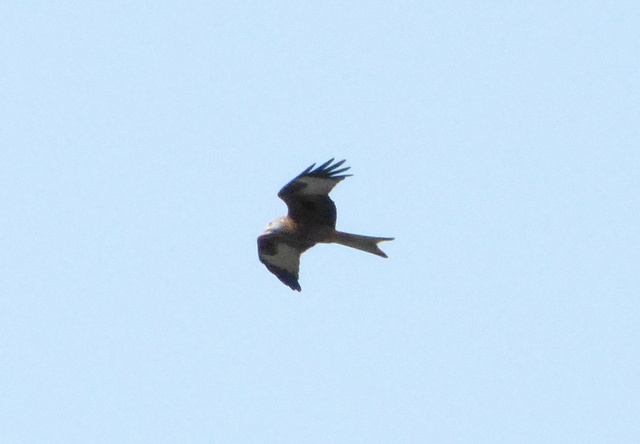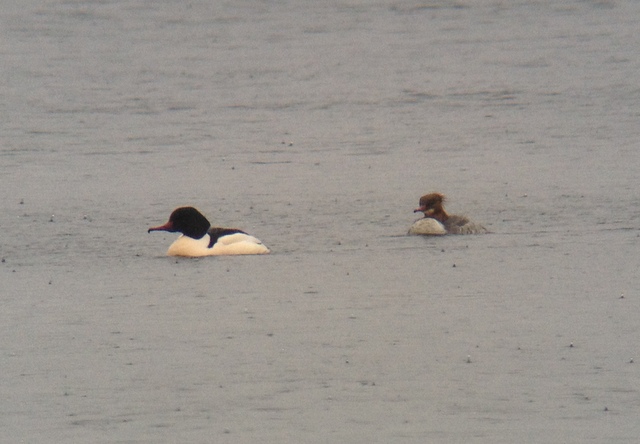Day 3 of a long weekend of tours, the last day. Today we headed down to the Brecks. If you had seen the weather forecast last week, you wouldn’t have wanted to come out at all this weekend. As it was, we had mostly great weather, at least until the last hour or so, and saw a fantastic number of birds. So much for the forecast – again!
We started at Lynford arboretum. With the suggestion it might be increasingly windy (if dry!!) in the afternoon, and given that seeing Hawfinch was a priority, this seemed to be the best approach today. There was lots of activity in the arboretum – a little group of Siskin buzzing in the trees flew off calling, a Goldcrest was singing from the depths of the firs, Nuthatches were piping from the heights, and a little party of Redwings called agitatedly from the tops of the pines.
There was no sign of any Hawfinches from the gate, but the sun had not yet reached the leaf litter and it was still very cold at ground level. A couple of Bullfinches were very nice, but not a perfect substitute for our main target. We walked on round the arboretum. Down by the bridge, a party of noisy Long-tailed Tits were clustered on one of the brick pillars, but no one had yet put the seed out which normally graces the top. A couple of Coal Tits were on the peanut feeder, and a Marsh Tit flew in but left as soon as it realised there was no food out yet.
We walked on round the paddock. This used to be the most reliable place to see the Hawfinches, but they have not been frequenting this area as much in recent years. We couldn’t find any warming themselves in the sun’s rays at the tops of the trees by the paddocks either, but fortunately one was perched up in a treetop in the grounds of Lynford Hall doing just that! We could see it distantly from the other side of the lake, and we just had time to get a look at it in the scope before it dropped down out of view. A good start – a female Hawfinch in the bag already – but we were left wanting more.
We had a quick walk round the wet woodland trail, finally getting better views of some Siskin and several Nuthatches, before heading back towards the arboretum. By now, there was quite a crowd gathered by the gate and according to one of the many photographers a Hawfinch had been down feeding a little earlier. We stopped to have a look ourselves.
When the crowd finally quietened down a little the birds started to fly down to feed. Initially, more Chaffinches dropped down into the leaf litter. Suddenly, from nowhere, a Hawfinch appeared as well. Initially, we could just see its head, as it fed behind the base of a tree, but we all got a look at it in the scope. Then it flew out and fed in full view – much better. We could see the large triangular bill, the white tail tip, the rich chestnut body plumage and the contrasting grey nape. There was a smart male Brambling in the leaf litter as well, but it got slightly ignored next to its much rarer cousin.
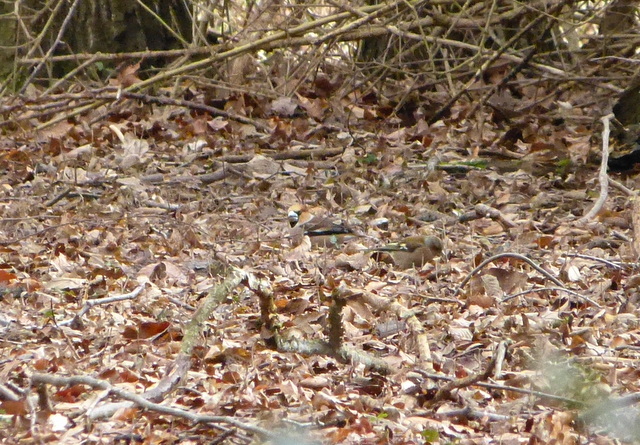 Hawfinch – surprisingly well camouflaged in the leaf litter, can you see it?
Hawfinch – surprisingly well camouflaged in the leaf litter, can you see it?
We were all pretty happy with that, and the bird eventually flicked up into the trees, but still we were not finished. Knowing one of the areas the birds favour, we moved along a couple of metres from the throng. It only took a minute or two before the Hawfinch dropped down again, but this time really close. We were ideally placed to get scope-filling views (and cracking photos!) of the bird – a really smart male Hawfinch. What a corker.
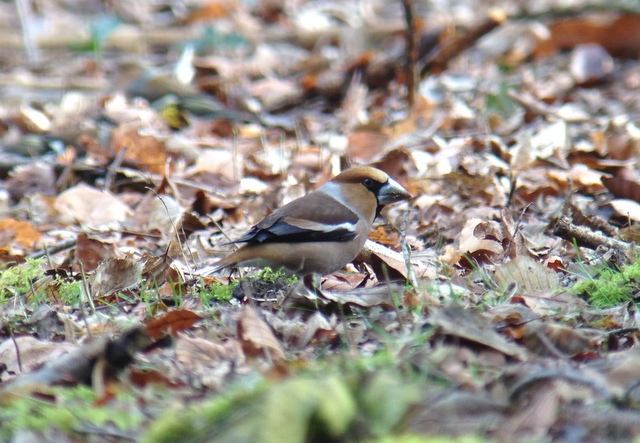
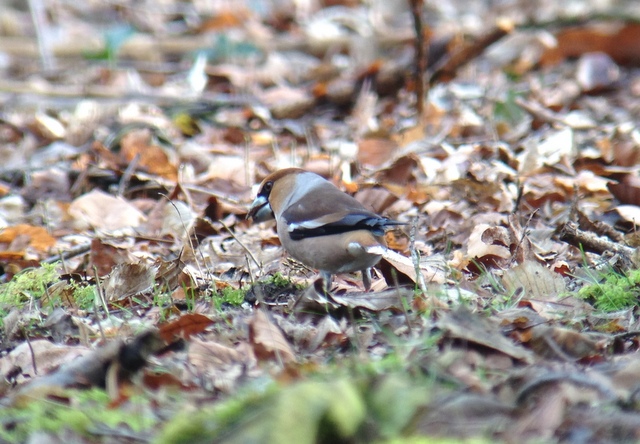 Hawfinch – cracking views of this male today, feeding right in front of us
Hawfinch – cracking views of this male today, feeding right in front of us
It was time to move on, and we did so with a spring in our steps now. Next target was Goshawk. Unfortunately, the weather had already started to deteriorate slightly – the cloud had rolled in, the sun had gone and a cold wind had picked up – much earlier than forecast. It didn’t feel as promising for Goshawks as it had first thing. However, there were at least 8 Buzzards in the air when we arrived, some of them soaring high into the sky and even giving a little bit of display – a good sign. A Red Kite drifted out over the trees. Pursued by a Buzzard, it came towards us, eventually drifting almost overhead. A Kestrel circled over the wood as well, but still no sign of our target.
With the wind picking up all the time and the temperature dropping, the Buzzard activity started to tail off. It seemed like we had missed the window of opportunity. Then the woods erupted and hundreds of Woodpigeons shot into the sky. At first nothing else appeared. Finally, a male Goshawk circled up from the trees – pale silvery grey above, and strikingly pale below. It had its white undertail coverts puffed out, wrapped around the sides of its tail, looking almost white-rumped as it turned. It drifted across the tops before dropping down again out of view. Target number two ticked off, we decided to move on.
Next stop was Lakenheath Fen. After an early lunch, and the use of the facilities, we headed out onto the reserve. We didn’t have time to explore the whole reserve today, but we wanted to have a look at Hockwold Washes. Even before we got to the Washland viewpoint, we saw the Great White Egret. It was flying along the river, its large size immediately apparent. It quickly dropped out of view and we headed up onto the river bank to see where it had landed.
From the viewpoint, we could see the Great White Egret standing amongst the reeds on the edge of the river further along. We got it in the scope and had a better look at its long, dagger-like yellow bill. We set off along the bank to get a little closer, but before we had got very far it took off again. Fortunately, we got some great flight views as it flew off – noting its long, bowed wings and slow, measured wingbeats, and its long, stick-like black legs with bunched black feet at the end.
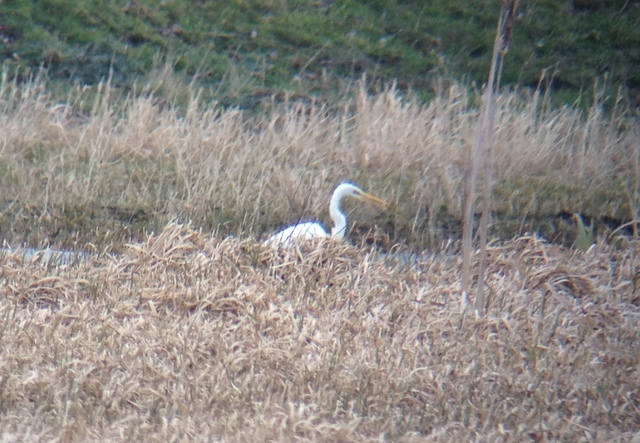 Great White Egret – at Lakenheath, in Suffolk, but only just!
Great White Egret – at Lakenheath, in Suffolk, but only just!
There were plenty of other things to look at from up on the river bank. A couple of Little Egrets nearby gave us a good chance to look at the differences. Hockwold Washes itself was full of ducks – Wigeon, Teal, Gadwall and Shoveler. There were a couple of very smart spring Great Crested Grebes as well. A Kingfisher perched up on the edge of the river. And a Stonechat was flicking around down among the reeds. However, it was now getting very windy, so we decided to head somewhere more sheltered.
Some of the group still hadn’t seen Brambling, having been too distracted by the Hawfinch earlier. There had been some here recently, but the staff at the visitor centre thought they were no longer present. However, on the walk back from the Washland viewpoint, there were lots of birds in amongst the sallows – Chaffinches, Goldfinches, Reed Buntings and tits. A careful scan through the birds perched up in the trees produced a smart female Brambling which we managed to get in the scope before the group moved on again.
We drove back to Santon Downham and walked down to the river. On the way, a couple of Marsh Tits were in the trees around the gardens. From the bridge, we could see a Kingfisher perched up on a branch along the river bank. A Song Thrush was in the process of smashing a snail along the path nearby. Then the rain started. We did a quick circuit of the fields, successfully negotiating the very slippery path alongside the river. Unfortunately,we couldn’t find the Great Grey Shrike here – it has been very erratic in recent days, probably roaming round quite a large area.
We returned to the car and set off back to Lynford. Despite the rain, there was time for one more walk. The lakes at Lynford Water have held the odd Goosander in recent weeks, so we thought it was worth a look. The first lake only had a little group of Tufted Ducks and a couple of Mute Swans. From the hide overlooking the second lake, we could only see two Great Crested Grebes. A young Sparrowhawk flew across the water, clutching something small in its talons. A couple in the hide told us that a pair of Goosander had been present earlier, but they had no idea where they had gone. We sat and waited, but nothing appeared.
Eventually, we decided to explore round the edge of the lake, to try to see into some of the bays not visible from the hide, and it didn’t take long before the pair of Goosander appeared and flew out into the middle of the lake. We watched them swimming, preening, diving. Beautiful ducks. A lovely way to end the day and a really good weekend.
